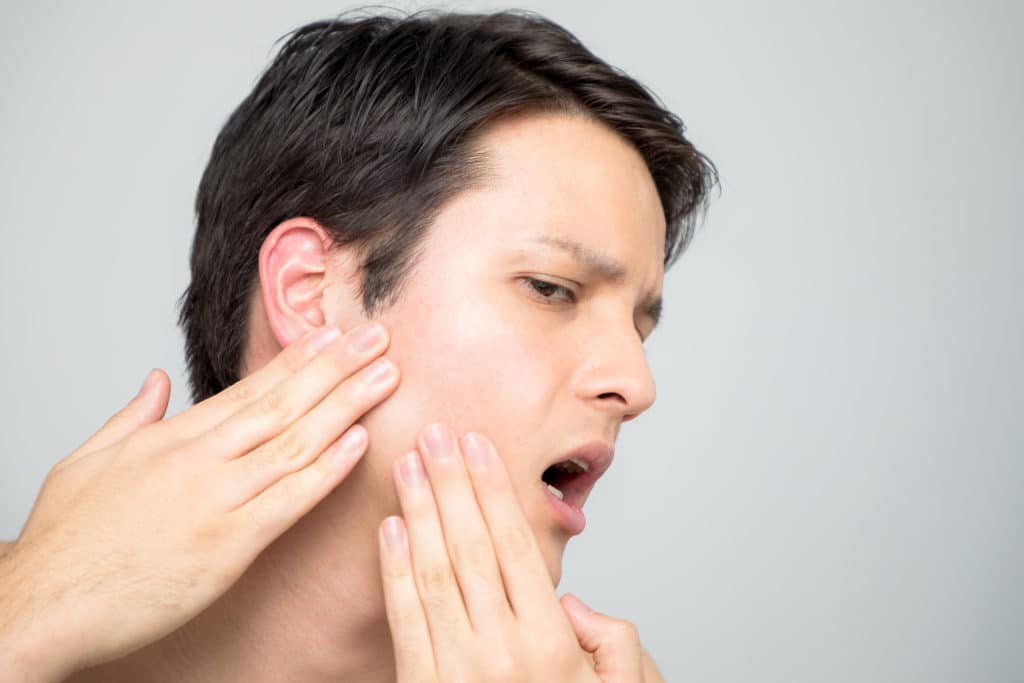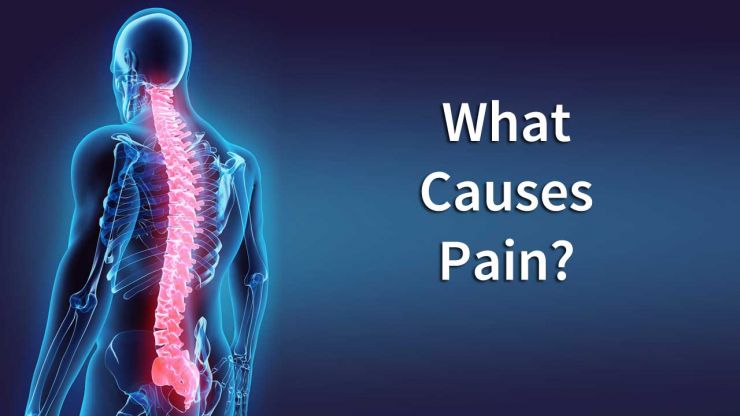When you’re having jaw discomfort, it’s debilitating. You’ll try anything. On any other day, getting out of bed to hit the gym is a bear. But when you’re suffering from TMJ disorder, you’ll run through TMJ exercises all day long, if they promise relief.
In this article, we’ll create an understanding of TMJ disorder, we’ll talk about when jaw exercises for TMJ may help, I’ll share FDA registered exercise equipment for the back and spine that may help, and I’ll tell you when you might be wasting your time with TMJ exercises.
Why Consider Jaw Exercises for TMJ?
Most people never give much thought to the joint of their jaw…until there’s a problem. And that is totally okay.
But when there’s a problem, here’s what you need to understand…
It’s usually not the TMJ that’s the problem.
Although that might be the case, its the least common cause of TMJ symptoms. TMJ symptoms are most commonly caused by a disharmony between how the TMJ, the muscles, and the jaws function together. And although, pain can result from many different areas, the most common source of pain from TMJ disorder is from the muscles.
So if TMJ pain is most often caused by the muscles, it’s natural to think about TMJ exercises. After all, exercise leads to healthy muscles, right? It’s perfect logic.
But hold your horses. It’s a bit more complicated than that.
TMJ Symptoms and It’s Causes
TMJ disorder is complex. The lower jawbone, the mandible, is one piece that connects on both sides of the head. Therefore, both sides have to operate in precise harmony, otherwise, it throws off the other side as well. Can you say snowball effect?
And what makes it worse is that it’s not just about the mandible. The mandible also links to the sides of the head by the temporomandibular joints, ligaments, muscles, tendons….and not to mention there are also 32 teeth that must also function together. And if that’s not all, tension from the shoulders and neck can also radiate to worsen TMJ disorder.
That’s a lot of things working together.
All these components make up the TMJ complex. So you can see how harmony matters. If any part of the system is out of harmony, it can snowball into massive amounts of tension.
For a moment, I want you to think of the TMJ complex as a canoe. Think of a canoe full of people each paddling. When everyone is paddling in the same direction, the canoe moves effortlessly. But what if one person is paddling the opposite direction? Suddenly the canoe team is working against itself. And everyone tires sooner.

Because the TMJ complex is a number of parts linked together, it’s like a canoe. Everything must be in harmony for things to work smoothly.
If there is disharmony in any one of the parts, stressful symptoms begin to arise. TMJ disorders may cause mild to severe symptoms, such as:
- pain while chewing
- pain in the ear
- painful clicking or popping when you open or close your mouth
- locking of the jaw
- headaches
- tension and soreness in the muscles of the face.
Do TMJ Exercises Work for Pain Relief?

But if you’re suffering from various symptoms, you want relief now. You’ve heard that TMJ exercises are something you can try at home to find relief. But do they really help?
Well, sometimes, but not always. Some studies have found that TMJ exercises provided no benefit. Sorry but I have to be honest with you.
But that doesn’t mean you can’t find relief. Let’s talk about that.
Exercises for TMJ may relieve pain temporarily. However, as we talked about TMJ disorder is quite complex. It can be caused by a number of different imbalances in the anatomy. Sometimes TMJ exercises and stretches can help to relieve the symptoms, but sometimes there’s other treatment that’s better suited.
Exercises for TMJ are thought to help by:
- Stretching the ligaments and muscles
- Allowing the lower jaw to rest in a different position
- Strengthening the jaw muscles
- Relaxing the jaw
- Increase jaw mobility
Jaw Exercises for TMJ
You’ll find a slew of various TMJ exercises and movements on the internet. I’ve tried to curate the most effective of the bunch and I’ll list them here.
The Jaw Muscle Relaxation Technique
This one’s first because it’s most important. The goal of this TMJ exercise does not exercise at all, but rather….rest.
You’ll find that when it comes to TMJ disorder, most people are searching for rest…not necessarily more jaw tension.
Rest your tongue gently on the top of your mouth behind your upper front teeth. Allow your teeth to come apart while relaxing your jaw muscles. Try to make this a habit as much as possible during your days of TMJ symptoms.
The TMJ Muscle Stretch
A major part of TMJ disorder has to do with muscle tension. One of the best ways to improve the bodies tolerance of muscle tension is by stretching.
With your tongue touching the roof of your mouth, slowly open your mouth until just before your tongue drops off the roof of your mouth. You should feel a stretch on the sides of the jaw. Hold this position for about 15 seconds and repeat throughout the day.
The Rest on a Pen Technique

A common cause of TMJ disorder has to do with how the top and bottom teeth close together. A simple TMJ exercise to rest the jaw by temporarily changing the position. Take a clean pen or pencil and allow your front teeth to gently rest on it.
The Opening Jaw Exercises for TMJ
The lateral pterygoids are a small muscle responsible for opening the jaw. To exercise these muscles, place your thumb under your chin to create a little resistance. Slowly open and close your mouth against the resistance 6-10 times.
The Closing Jaw Exercises for TMJ
There are several muscles responsible for closing the jaw including the temporalis, the masseters, and the medial pterygoids. To exercise these muscles, hold your chin with your hand and apply downward force. Close your mouth as you place gently pressure on your chin.
The Forward Jaw Relaxation Technique
The top front teeth serve as a fence for the lower front teeth. When you bite, the lower jaw must operate in a narrow range to clear behind the upper front teeth. Over time, this can create strain.
To test if the position of your front teeth is creating strain, put a clean pen or pencil between your front teeth. Allow your jaw to sit as naturally forward as it feels comfortable to relax the jaw.
Side-to-side Jaw Exercises for TMJ
Increasing the range of movement is important for normal muscle function. The jaw usually gets enough motion up and down from chewing, but it’s also good to stretch in a side direction.
Gently open and wiggle your jaw side to side slowly with a mild stretch at each side.
Back, neck, and Spine Exercises for TMJ

The back, spine, and neck can sometimes contribute to TMJ symptoms. Often people that have spinal pain also present with TMJ pain, and vice versa. And although these issues sometimes may not be related, its often good to rule out if a spinal issue is compounding to TMJ disorder.
Traction devices
TMJ pain often can have a neurological component. After all, pain is a sensation felt from a source, but it’s transmitted by the nerves. Pain can affect more than one location. The cranial and spinal nerves can often refer pain from one body part to another. Therefore, if you are having back or neck tension or compression of the spine from poor posture… the pain can make its way to the head and jaw.
Traction devices for the spine can help to rule out if treating your neck and spine has an effect on your other TMJ related issues. There are numerous traction devices available but a good one to consider is the FDA-registered Teeter inversion table.
Posture
Our posture has an incredible effect on how we feel and it’s so easy to forget. Be mindful throughout the day to practice good posture. Avoid unsupported leaning when sitting. Stand up straight. And keep your arms supported on tables or armrests. Be aware of repetitive motions you do during the course of the day that could be causing strain.
Chin tucks/Neck Stretches
Neck strain can be referred to the jaw. After all the neck and the jaw are pretty close in proximity and even share many of the same nerves.
To perform a chin and neck stretch, pull your chin strain back creating a double chin look. Be sure to keep your shoulders back and chest up. Hold for three seconds and repeat 10 times. Next, stretch your neck by tilting your neck back and holding a stretch for three seconds. Repeat 10 times.
Other ways to cope with your TMJ pain

Over-the-counter pain relievers such as ibuprofen and acetaminophen help to relieve TMJ pain. Warm compresses on the area can provide some benefit. And muscle relaxers may also be prescribed by a physician or TMJ dentist.
But the important thing to realize is that many of these methods are just masking the problem. Exercise and pain relievers can only go so far in treating TMJ dysfunction. If you have been suffering from muscle pain, headaches, ear pain, jaw pain for more than a few weeks…that’s no way to live. There are probably better options to treat your symptoms.
Some options that a TMJ specialist may recommend are:
- Customized mouth guards called orthotics to treat TMJ disorder
- Orthodontics
- Balancing the bite, also called equilibration
- Botox of the muscles of the jaw
- Restorative dentistry to correct wear or missing teeth
- Acupuncture to relieve pressure in the affected area
- Neurological treatment with a neurologist
- Physical therapy and chiropractic therapy for the neck, spine, and shoulders
Wrap Up: What You Need To Know
Sometimes TMJ symptoms are transient and short-lived. But sometimes early symptoms can be a sign of a worsening underlying TMJ disorder. Try TMJ exercises and some of the techniques listed above.
If your symptoms do not improve in a few weeks you should consider following up with your primary care physician, dentist, or a TMJ specialist.


